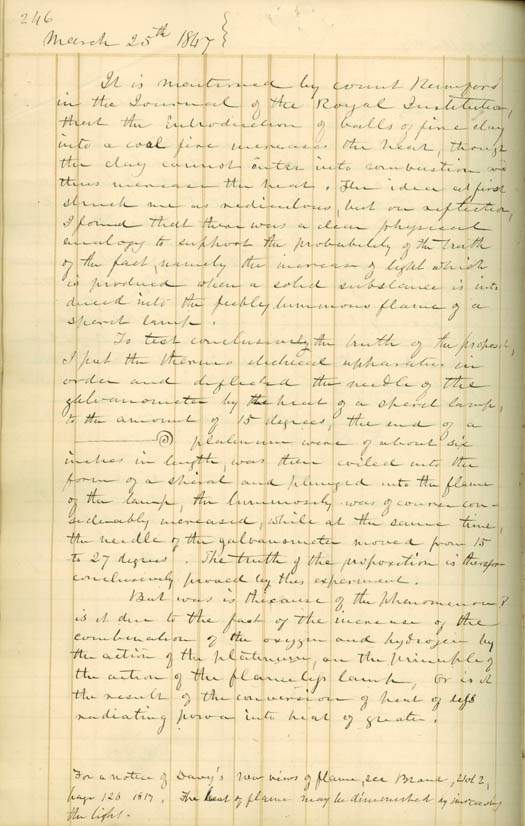 |
|---|
| Henry Documents |
| Chronology |
| Scientists index |
| Bibliography |
| Glossary |
|
Joseph
Henry | ||||
|
DOCUMENTS
| ||||
| .29. "RECORD OF EXPERIMENTS" | ||||
| March
25th 1847 It is mentioned by count Rumford in the Journal of the Royal Institution that the Introduction of balls of fine clay into a coal fire increases the heat though the clay cannot enterA into combustion and thus increase the heat.1 The idea at first struck me as rediculous but on reflection I found that there was a clear physical analogy to support the probability of the truth of the fact namely the increase of light which is producd when a solid substance is intoduced into the feebly luminous flame of a sperit lamp. To test conclusively B the truth of the proposition I put the thermo electrical apparatus in order and deflected the needle of the galvanometer by theC heat of a sperit lamp to the amount of 15 degrees the end of a platinum wire of about six inches in length was then coiled into the form of a spiral and plunged into the flame of the lamp the luminosity was of course considerably increased while at the same time the needle of the galvanometer moved from 15 to 27 degrees. The truth of the proposition is therefore conclusively proved by this experiment. But was is theD cause of the phenomenon? is it due to the fact of the increase of the combination of the oxygen and hydrogen by the action of the platinum on the principle of the action of the flameless lamp2 or is it the result of the conversion of heat of less radiating power into heat of greater.3 For a notice of Davy's new viws of flame see Brand Vol 2 page 126 1817. The heatE of flame may be diminished by increasing the light.4Henry Papers, Smithsonian Archives. The final paragraph is at the bottom of the page following a blank space and may be a later addition. | ||||
| 1 Benjamin Thompson, Count Rumford, "Observations Relative to the Means of Increasing the Quantities of Heat Obtained inthe Combustion of Fuel," Journals of the Royal Institution of Great Britain, 1802, 1:28-33. A copy of this volume survives in the Henry Library, with an annotation (p. 29) to Rumford's remark that there were no good quantitative data regarding the amount of heat thrown off by different substances when raised to the same temperature. | ||||
| 2 The flameless lamp was an alcohol lamp with a fine platinum wire coiled around the wick. Once the lamp was lit, the wire would continue to glow red hot even after the flame was extinguished. The theory of the flameless lamp was that the platinum wire retained enough heat to continue the combustion of the alcohol at a level sufficient to maintain the temperature of the wire but insufficient to reignite the alcohol. J. L. Comstock, "Description of the Aphlogistic Lamp," Silliman's Journal, 1822, 4:328-331. | ||||
|
3
Henry
summarized his thoughts
regarding Rumford's assertion
in the first two pages of a four-page memorandum, In "Speculations on Light and heat," Henry first hypothesized that the cause of the increase of the heat was an increase in combustion. He laid out a number of experiments "for settling the question." The first, using thermoelectric apparatus, was conducted on this date. We have not been able to document the others, which are comparisons of the amount of fuel burnt in given time periods with or without the platinum wire. In the second half of the memorandum, however, Henry suggested a different explanation. Spurred by the memory of a remark by Bache in Washington "a few days ago," Henry speculated that introducing the solid matter shortened the wavelength of the radiant heat, increasing its heating power. His 1855 paper presented this explanation, relying upon experiments utilizing a spirit lamp, documented in the March 1847 "Record of Experiments" entries, and those using a hydrogen jet, for which we have not found documentation. /P> | ||||
| 4
Humphry Davy, "Notice of Some
Experiments and New Views
Respecting Flame," Quarterly Journal of Science, | ||||
|
A
Altered
from entre |

